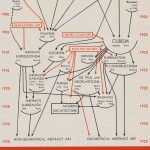Lesson 50
In the 1980s I put forward on an alternative art history. This was alternative to an academic/Courtaulds or a Kenneth Clarke art history which tends to see art history as purely the history of styles and forms.
We see in Alfred Barrs flow chart of MoMA a similar linear attitude, art exclusively coming from art. However, history is not linear. With Barrs there is no reference to the First World War or the Russian Revolution or the Great Depression in America for a example. In fact, no reference to any ‘real’ history at all. The problem with this art history is that it is, simply, non historical!
The Development of Abstract Art. Alfred Barrs flow chart. [Thumbnail]
In my alternative art history I began by comparing a Henry Ford Model T of 1909 with Picasso’s Les Demoiselles D’avignon of 1907 and posed the question which was the most modern? The car seems to have dated much more and badly than the painting. Picasso’s painting, though over one hundred years old, would still be considered ‘modern art’ and is as fresh as the day it was painted, whilst the car is vintage.
Les Demoiselles D’avignon is often described as the most important painting of the 20th century and that it was ‘unfinished’. When I first saw Les Demoiselles at MoMA in New York it was clear to me that it was an abandoned painting, not simply unfinished. Picasso radically changed his mind about it half way through. How could he finish it? Should all the Liberian-style figures take on that primitive African style? That ‘compelling, even savage force‘. Should he have totally repainted it? That would be a different painting, better abandon it, just stop, and pursue this newly discovered primitive manner on other canvases.
The painting was hidden away for 9 years (painted 1907 and not exhibited until 1916). It’s not a good painting, well not his best, not a great painting, and it’s only significance is an Art Historical one. It fits in with a Modernist theory of the development of Modernism in the 20th century. It is part of the debate about Primitivism and Modernity. How could it be the most important painting of the 20th century? The painting is a leap. A clear shift from what has done before. It is the missing link, that is if it was missing and it almost was. It’s great importance is solely to art historians and it does not deserve its status as a ‘painting’.
One might say that Les Demoiselles D’avignon now has new status as its eclecticism seems Post Modern and the appropriation of African masks could represent a Post Modern aesthetic, but again that’s just more art historian’s games.
However what would be worth discussing would be its relation with French colonialism.
It is obvious that things such as colonialism, wars, revolutions, economic crisis, the Cold War, civil rights struggles, ethnic cleansing, have an enormous impact on the art of individuals and nations. Indeed, the contents of any countries national museums depict their imperial or colonial past. Art has to be put into a real historical context. Of course many artists would consider themselves apolitical with their head buried in the proverbial sand, but this does not mean that their art does not exist in a socio-political or historical context.
Only with an art history that includes the First World War do you have a chance of understanding Dada. All art needs to be seem in it’s correct political and historical setting.
As Peter de Francia once pointed out – “Tatlin’s tower cannot be understood in a vacuum that ignores the political events of 1923…Nor can the ideas of Beuys and Düsseldorf be tossed into an imaginary bull-ring without an understanding of the background to the German student movement of the early sixties.“
Philip Guston said that three world events influenced his painting: the Holocaust, the Vietnam War and Chile, (that is, the coup against President Allende and the rise of the fascist dictator Pinochet). Yet writers on his work tend to construct a nicotine stained, boozing, pill-popping character, who suffered anxiety depressions and suicidal tendencies or as some sort of renegade abstract expressionist.
Historians seem more interested in who Picasso was sleeping with than the political context he lived through. Might not Picasso’s politics – that is, his membership of the French Communist Party for instance – have as much or more bearing on his work than his sex life might seem to have?
The cult of the personality should not be more important than history in any art history.
To continually celebrate the individual has ceased to be of interest for me. As a friend of mine once said “I want to be an individual like everybody else“.
In my alternative art history in the 1980s, I questioned the notion of internationalism, and the so-called the International Style of Modernism. European art has moved from various city centres, from Florence, Rome, Venice in the 14th to 16th centuries and Paris, New York, London, Tokyo etc, in the 19th and 20th centuries, but this line is not comprehensively international, in that it does not concerns itself with what we might today understand as ‘world art’. This internationalism is a exclusively European.
I asked the students to name a Vietnamese artist, a South American artist or a North African artist and, of course, none of them could. However, with a broader cultural view of a nations diversity and a kind of cultural ‘globalisation’, which has now become part of the Post Modern landscape, one would hope that today’s students could name a greater diversity of artists from a greater variety of countries than their counterparts in the 1980s.
Barrs’ linear flow chart is Modernist, but Post Modernism view would not recognise this linear development. Post Modern relationships would be best described as a network. At Liverpool Tate we see diagrams of ‘constellations’ of artists. Artists connected differently than in schools and isms or in any sense that there is a linear direction or developmental relationship. Modernism had a trajectory but Post Modernism is directionless. Art historians are now allowed to connect artists in any way they might wish, even randomly, in fact, just like we do as viewers when we walk around a gallery
Tate Liverpool, Diagram. [Thumbnail]
Most ‘isms’ last for about 10 years. However, this Post Modernism or Post Post Modernism is now over 30 years old with no signs of an alternative or transforming. There also seems little art history being written after 1980, other than a kind of journalistic art criticism that celebrates the individual and minor fashion changes which includes the popular culture and technological innovation. To describe the current diversity in art in a historical context is difficult but not impossible, even though art synchronically does different things and does not seem to be going anywhere.
Are we are stuck in a stagnant pluralist swamp without the means of extracting ourselves?
Of course art in the 20th century was always been pluralistic; however, anything outside the strict confines of Modernism rarely got a look in, but that does not mean to say it was not produced. Under Modernism, pluralism was antagonistic, figurative painting and earlier forms of art practice did exist whilst Abstraction was favoured, but they never went away. Artists who did not adhere to Modernist ideas were considered old fashioned as they went against the dominant ideology. These artists were overlooked even if their work was ‘new’ and fresh. Today pluralism is dominant, and all the different modes of painting and contemporary practice live together happily. In the 1970s if an abstract painter shared the same studio as a painter of flowers, they would have killed each other. Today, I have said, they are probably f**king each other.
Today’s artists are not ideological in the same way as their predecessors and they appear more tolerant and less combative. We need to ask ourselves if this appearance of democracy is a good thing.
Pluralism aided by the market aspires to mediocrity.
Art changes like hair styles change, there is nothing but fashion.
Groundhog Day.
Like the needle on an old vinyl record player that has finished playing and is stuck in the grove in the middle, scratching round and round on an empty carousel, continually repeating itself.
Is there an alternative to Pluralism?
Pluralism seems to be resistant to any alternative.
Pluralism is a black hole that will suck in anything that gets near it.
Is there the possibility of an alternative art history today? Unfortunately there isn’t anything to be alternative to. We have too many alternatives, too many art histories: we have networks of art histories and the popular culture, we have a women’s history of art, a black history of art, a working class history of art, a gay history of art etc and the ivory tower, hermetically sealed, elitist, Imperial, colonial, racist, non historical history of art, is no longer dominant but is just one history amongst many others.
What is the alternative to Pluralism? A single over arching dominant ideology?
Nobody seems to have the stomach for this.
‘Against pluralism’ somehow seems undemocratic.
How do we drain the swamp?
Where would be get a new road map from?
As stated in Lesson 47 – “Concepts in art are determined in a given society by what is seen as the relationship to the past or to the future. It seems that now the future is no longer a relevant notion in these ‘groundhog days’…“
‘History has stopped. Nothing exists except endless present…‘ George Orwell 1984.
Beyond Pluralism
It is over 25 years since Francis Fukuyama got his 15 minutes of fame by declaring the ‘End of History’, and supposedly we were entering this new epoch of Post-Modernity in which the big ideologies and political questions that animated the world were settled and that the traditional idea of history and progress was no longer relevant. In art the big ideologies have been replaced by appropriation, pluralism, the fetishism of merchandise of the market and the anti ideological (which is an ideology in itself).
Pluralism provides the artist with the opportunity to do whatever they might wish to do. However, pluralism does not offer the ideology to discriminate. There is no longer a clear pathway for the artist or art student to follow in this ‘stagnant swamp‘. To re-contextualise Berger and not to mix my metaphors too much, ‘this is the freedom of the desert island‘.
But the economic crisis unleashed by the collapse of Lehman Brothers has not only exposed the dangerous underpinning of free market capitalism yet again, but it has brought about a return to ideologies in politics (and a polarising of these ideologies). Have we reached the point where we can see and end to ‘globalisation’ and a return to history? A return to the security of the nation state? It might seem that through social media we are more connected but this is a herding of beliefs in an echo chamber and not a search for the truth. We have returned to the debate about ‘us and them’, the antagonist relationships between peoples and nations.
Back to the Future.
Politics is looking at the big ideological questions again. However this transformation has, as yet, to fully materialise itself in art.
This entry was posted on Monday, July 10th, 2017 at 10:11 am
You can follow any responses to this entry through the RSS 2.0 feed.


